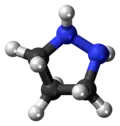Pyrazolidine
Pyrazolidine is a heterocyclic compound. It is a liquid that is stable in air, but it is hygroscopic.[2]
| |||
| Names | |||
|---|---|---|---|
| Preferred IUPAC name
Pyrazolidine[1] | |||
| Other names
1,2-Diazolidine | |||
| Identifiers | |||
3D model (JSmol) |
|||
| ChEBI | |||
| ChemSpider | |||
PubChem CID |
|||
| UNII | |||
CompTox Dashboard (EPA) |
|||
| |||
| |||
| Properties | |||
| C3H8N2 | |||
| Molar mass | 72.10902 | ||
| Density | 1.00 g/cm3 (20 °C)[2] | ||
| Melting point | 10 to 12[2] °C (50 to 54 °F; 283 to 285 K) | ||
| Boiling point | 138[2] °C (280 °F; 411 K) | ||
Refractive index (nD) |
1.477[2] | ||
Except where otherwise noted, data are given for materials in their standard state (at 25 °C [77 °F], 100 kPa).
Infobox references | |||
Preparation
Pyrazolidine can be produced by cyclization of 1,3-dichloropropane or 1,3-dibromopropane with hydrazine:[2]
See also
References
- International Union of Pure and Applied Chemistry (2014). Nomenclature of Organic Chemistry: IUPAC Recommendations and Preferred Names 2013. The Royal Society of Chemistry. p. 142. doi:10.1039/9781849733069. ISBN 978-0-85404-182-4.
- Buhle, Emmett L.; Moore, Alexander M.; Wiselogle, F. Y. (1943). "The Configuration of Tervalent Nitrogen. A Bicyclic Hydrazine Derivative1". Journal of the American Chemical Society. American Chemical Society (ACS). 65 (1): 29–32. doi:10.1021/ja01241a009. ISSN 0002-7863.
This article is issued from Wikipedia. The text is licensed under Creative Commons - Attribution - Sharealike. Additional terms may apply for the media files.

